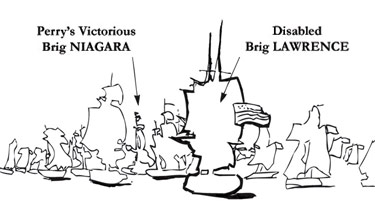|
Thomas Birch. Perry's Victory on Lake Erie. 1814.Oil on canvas, 66"x 96 1/2". Headbar Painting by John Neagle. The Studious Artist. 1836. Viewing Thomas Birch’s 5’h x 8’w painting, a museum docent might begin by directing your attention to the compositional elements that John Wilmerding, the prominent American marine curator, describes as the four elements of the Dutch marine school of painting. of painting:
Wanting to help us identify the fleet, our guide might note that in the foreground, at the very apex of his pyramidal composition, Birch has placed the largest ship in the painting, a battered but buoyant brig, enhanced by an oversized This is actually the Lawrence, Perry’s abandoned, disabled, unengaged brig. Trying to find the Niagara among the 14-16 other vessels is a challenge, because the composition obscures its role in the battle. Looking more closely, we finally see the Niagara almost a half mile away, so small and insignificant that Perry and his brave men are completely lost to viewers who lack extensive knowledge of the battle (see illustration identifying the fleet). We might also wrongly assume that the time of battle in this picture is around 9:00 am, not 2:30 pm. Birch has established the time of day by painting a gradient orange morning sunrise ascending from the lower left horizon line, chasing away the last of the darker night clouds that cover more than half of the top right portion of the painting. Birch has further established that east is on the left by painting the sun’s highlights on the left sides of all the sails while the ships cast darker shadows on the water to their right. Judging from the fullness of the sails and the American flags being blown almost straight out, there is a strong wind coming from the east, rather than a mild southeastern wind. Curiously, we count two more American sailing vessels than were actually involved. What is very impressive is seeing two entire fleets of Tall Ships in combat in one painting. Why did Birch diminish and obscure the significance of Perry's role and exaggerate the importance of the number of American vessels? One interpretation is that Birch wished to tell a more general story, in which credit is given to the entire fleet. Another is that he wanted the painting to reflect well on the Philadelphia politicians who supported the vision of a strong top-down naval command and minimized the role of individual officers. To convey his interpretation, Thomas Birch pulls the viewer’s perspective back to a safer distance behind the half-destroyed Lawrence, outside the lines of engagement and away from the blood, giving an overview of the entire battle. Return to Top John Wilmerding writes that Birch "…played up to the taste for patriotic storytelling†(80). Thus, politics may have influenced artistic license. Without diminishing Birch’s masterpiece or his great artistic abilities, this may explain the many omissions, exaggerations and inaccuracies in the painting. Another interpretation is that the artist minimized Perry’s role because, as John Wilmerding confirms, Birch was not a sailor. He did not have the practical knowledge required to show the navigational complexity of what really happened. Thomas Birch was born in England in 1779. At the age of fifteen, he came to Philadelphia, the nation's cultural artistic center and a flourishing international port. He was taught to paint by his father, an English enamel painter and engraver, and learned about the Dutch tradition through his father's collection of Dutch marines that apparently "…included works by Van Goyen and Ruisdael" (Wilmerding, 74). Birch soon established a reputation as a popular portrait and marine painter, and at 25 he was elected to the Pennsylvania Academy of the Fine Arts. According to Wilmerding, Birch "…. found himself more at home depicting only two vessels in direct action with each other…. [But] he also composed pictures around more complex groupings such as Perry's Victory on the Battle of Lake Erie and the Battle of Lake Champlain…These dramatic seascapes are the fullest expression of the Dutch marine tradition in Birch's work†(77). Giving the highest praise to his mastery of the Dutch compositional elements and skill in creating beautiful paintings, Wilmerding ranks Thomas Birch among the very best of our American Marine Artists. For more information on Thomas Birch's paintings, contact the Pennsylvania Academy of the Fine Arts www.pafa.org Comparison to the Julian O. Davidson paintingReturn to Top |




 American flag in perfect array. We assume this ship to be the heroic Niagara, but in this case, size does not correlate with importance.
American flag in perfect array. We assume this ship to be the heroic Niagara, but in this case, size does not correlate with importance.